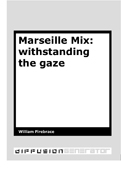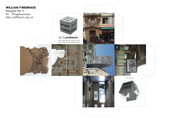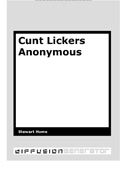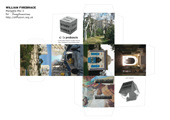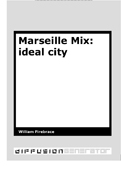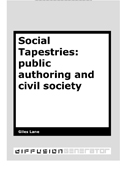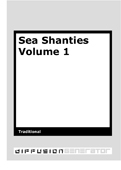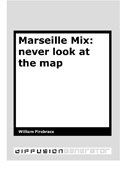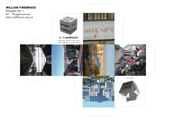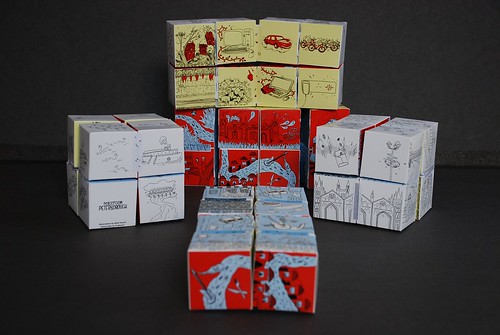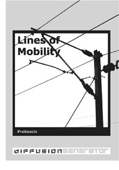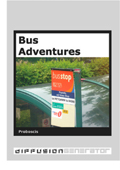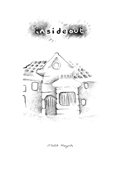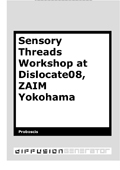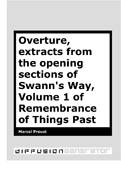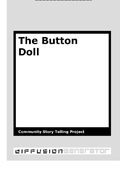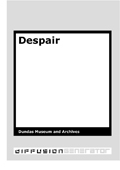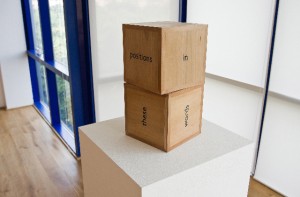Articles by Giles Lane
Giles Lane is founder and co-director of Proboscis. He conceived of and developed the Diffusion eBook format with Paul Farrington and designed the Proboscis StoryCube.

Download A4 | US Letter PDF 379Kb
StoryCube A4 only PDF 703Kb
About : withstanding the gaze – a germanic literary diversion. Fourth in a series of 6 eBooks and StoryCubes published weekly, feuilleton style.
Marseille Mix
My first encounters with Marseille were in the cinema, in films such as The French Connection, La Ville est Tranquille and Taxi. It seemed a strange place, dangerous, not conventionally beautiful, down at heel, but somehow attractive. I decided on the basis of this cinematic introduction that this was the city I wished to write about – exactly because it did not coincide in any way with what I considered to be a city, because of its defiance.
Marseille is an irreconcilable mix – of different cultures, different societies, different ideas about the planning, different images, different gastronomies. It evokes fantasy as much as objectivity. As a city it inspires dislike and fear but also pride and love.
It is not possible to investigate this city in a linear, coherent fashion, since the city is in no way linear or coherent.
Marseille Mix contains various methods of writing – narrative, essay, recipe, lists, conversations, chance remarks, and others. Sometimes it flows easily enough, sometimes it accepts the need for contradiction, disruption, lack of resolution. Of course the book is not really exactly like the city – it is a personal investigation, with its own points of view.
Published November 2008 in the Diffusion Transformations Series
William Firebrace is an architect, and teaches in various London schools of architecture. He has published one book, Things Worth Seeing (Black Dog 2001), has completed a second, Awake, and is now finishing a third, Marseille Mix, which should appear in 2009.
Unit 2, Bartlett School of Architecture, UCL

Download A4 | US Letter PDF 677Kb
About : An almost fictionalised account of the sleaziest aspects of the London art and literary worlds in the mid-1990s. This is for broad minded adults, please do not read if you are easily offended.
Published November 2008
Stewart Home is an artist who has used social networking sites such as MySpace as the location for much of his non-gallery work in recent years. He is also the author of many books of fiction and cultural commentary, including 69 Things to do With a Dead Princess (Canongate, 2002), and The Assault on Culture: Utopian current from Lettrisme to Class War (AK Press 1991). His latest novel is Memphis Underground (Snowbooks, 2007). Online resources relating to Stewart Home’s work can be found at
www.stewarthomesociety.org

Download A4 | US Letter PDF 455Kb
About : How to go beyond punk but remain punk by grooving to soul and funk, as well as sixties garage acts like The Troggs (with the truly filthy origins of their name revealed for the first time ever)!
Published November 2008
Stewart Home is an artist who has used social networking sites such as MySpace as the location for much of his non-gallery work in recent years. He is also the author of many books of fiction and cultural commentary, including 69 Things to do With a Dead Princess (Canongate, 2002), and The Assault on Culture: Utopian current from Lettrisme to Class War (AK Press 1991). His latest novel is Memphis Underground (Snowbooks, 2007). Online resources relating to Stewart Home’s work can be found at
www.stewarthomesociety.org

Download A4 | US Letter PDF 376Kb
StoryCube A4 only PDF 752Kb
About : dangerous liaisons – some short and seedy criminal narratives. Third in a series of 6 eBooks and StoryCubes published weekly, feuilleton style.
Marseille Mix
My first encounters with Marseille were in the cinema, in films such as The French Connection, La Ville est Tranquille and Taxi. It seemed a strange place, dangerous, not conventionally beautiful, down at heel, but somehow attractive. I decided on the basis of this cinematic introduction that this was the city I wished to write about – exactly because it did not coincide in any way with what I considered to be a city, because of its defiance.
Marseille is an irreconcilable mix – of different cultures, different societies, different ideas about the planning, different images, different gastronomies. It evokes fantasy as much as objectivity. As a city it inspires dislike and fear but also pride and love.
It is not possible to investigate this city in a linear, coherent fashion, since the city is in no way linear or coherent.
Marseille Mix contains various methods of writing – narrative, essay, recipe, lists, conversations, chance remarks, and others. Sometimes it flows easily enough, sometimes it accepts the need for contradiction, disruption, lack of resolution. Of course the book is not really exactly like the city – it is a personal investigation, with its own points of view.
Published November 2008 in the Diffusion Transformations Series
William Firebrace is an architect, and teaches in various London schools of architecture. He has published one book, Things Worth Seeing (Black Dog 2001), has completed a second, Awake, and is now finishing a third, Marseille Mix, which should appear in 2009.
Unit 2, Bartlett School of Architecture, UCL
why are we who we are? what do we want to become?
Transformations is the latest series of Diffusion commissions curated by Proboscis. Proboscis is commissioning a diverse range of writers, artists, performers, thinkers and makers to respond to two questions from different perspectives, why are we who we are? and, what do we want to become?
As we get into the swing of the 21st Century our notions of identity, personal and societal, are subject to new arrays of emerging pressures and responsibilities. Our aspirations for change and growth are being re-thought as we grapple with the growing awareness of environmental changes which may already be beyond our control. How have we reached this point? Where do we go from here?
Transformations seeks to address these fluid notions of identity and aspiration by commissioning works that subtly reflect on individual identities, urban identity and pharmaceutical, biological and technological interventions. Over the next few years we will be inviting selected contributors to add their voices into this mix – through essays and artists books (eBooks) as well as in three dimensions (StoryCubes).
Add Your Voice
For the first time we are experimenting with a new approach to selecting works for this series – publishing as a conversation. Readers are invited to submit their own proposals for the series (through the comments section of this site) – we will provide accounts for the Diffusion Generator (soon to be re-launched as Bookleteer) for readers to become authors and create their own eBooks or StoryCubes, the best of which we will publish as contributions to the series. We are not asking for quick responses, but for measured and considered contributions to the series – putting an eBook or a set of StoryCubes together is significant creative act. Get in touch if you are inspired by the works we have selected and published so far and have a proposal for a work of your own.
The Contributions
- Wagenvoort: The Octuplets: Story of Our Lives
- Canales, Ransquin & Salazar: H2O
- Raqs media collective: 3 cubic conundrums
- William Firebrace: Marseille Mix – along the beach
- William Firebrace: Marseille Mix – turn down the heat
- William Firebrace: Marseille Mix – withstanding the gaze
- William Firebrace: Marseille Mix – Dangerous Liaisons
- William Firebrace: Marseille Mix – ideal city
- William Firebrace: Marseille Mix – never look at the map
- Kenneth Goldsmith: Pharmaceutical Cubes
We are seeking a sponsor for Transformations who shares our ethos of collaboration, public authoring and creating cultures of listening. Please contact us for more information.

Download A4 | US Letter PDF 405Kb
StoryCube A4 only PDF 752Kb
About : ideal city – a personal tour of the destruction and reconstruction of the city. Second in a series of 6 eBooks and StoryCubes published weekly, feuilleton style.
Marseille Mix
My first encounters with Marseille were in the cinema, in films such as The French Connection, La Ville est Tranquille and Taxi. It seemed a strange place, dangerous, not conventionally beautiful, down at heel, but somehow attractive. I decided on the basis of this cinematic introduction that this was the city I wished to write about – exactly because it did not coincide in any way with what I considered to be a city, because of its defiance.
Marseille is an irreconcilable mix – of different cultures, different societies, different ideas about the planning, different images, different gastronomies. It evokes fantasy as much as objectivity. As a city it inspires dislike and fear but also pride and love.
It is not possible to investigate this city in a linear, coherent fashion, since the city is in no way linear or coherent.
Marseille Mix contains various methods of writing – narrative, essay, recipe, lists, conversations, chance remarks, and others. Sometimes it flows easily enough, sometimes it accepts the need for contradiction, disruption, lack of resolution. Of course the book is not really exactly like the city – it is a personal investigation, with its own points of view.
Published November 2008 in the Diffusion Transformations Series
William Firebrace is an architect, and teaches in various London schools of architecture. He has published one book, Things Worth Seeing (Black Dog 2001), has completed a second, Awake, and is now finishing a third, Marseille Mix, which should appear in 2009.
Unit 2, Bartlett School of Architecture, UCL

Download A4 | US Letter PDF 597Kb
About : Social Tapestries was a programme of projects run by Proboscis between 2004 to 2008, and followed on from the Urban Tapestries project. This eBook provides an overview of our aims and objectives as well as some of the key projects which we undertook, including Snout, Robotic Feral Public Authoring, Conversations and Connections, Everyday Archaeology and Experiencing Democracy.
This publication coincides with the Digital Cities: London’s Future exhibition at the Building Centre in London (21 Nov 2008-17 Jan 2009).
Published November 2008
Giles Lane is an artist, researcher and teacher. He founded and is co-director of Proboscis, a non-profit creative studio based in London where, since 1994, he has led projects such as Urban Tapestries; Snout; Mapping Perception; Experiencing Democracy; Everyday Archaeology; and Private Reveries, Public Spaces. Giles is a Visiting Tutor on the MA Design Critical Practice at Goldsmiths College (University of London) and is a Research Associate of the Media and Communications Department at London School of Economics. Giles was elected a Fellow of the Royal Society of Arts in 2008 for his contribution to community development through creative practice.

Download
Sea Shanties Volume 1 A4 | US Letter PDF 360kb
Sea Shanties Volume 2 A4 | US Letter PDF 395kb
Selected and Introduced for Short Work by Francis McKee, director of Glasgow International (2004-08), CCA Glasgow and Research Fellow at Glasgow School of Art.
Beyond society’s canons of literature there are the outlaws – songs and stories that survive in the wild. Sea shanties are among the hardiest of these forms and all the more remarkable for having their roots in a vanished world of sailing ships. There is a raw surrealism in sea shanties that is bred from endless nights in the belly of tomb-like wooden hulks floating on deep swelling oceans. The wild ramblings (‘Cape Cod kids ain’t got no sleds/They slide down the hills on codfish heads’) are tempered by the disciplined, rope burned, rhythms of the nautical work song. It is this emphasis on hard manual labour, combined with a sailor’s wicked word play, which gives these songs their enduring appeal. You can sense their influence behind Shakespeare’s sea song in The Tempest:
Full fathom five thy father lies;
Of his bones are coral made;
Those are pearls that were his eyes;
Nothing of him that does fade,
But doth suffer a sea-change
Into something rich and strange.
Sea-nymphs hourly ring his knell:
Ding-dong,
Hark! Now I hear them – Ding-dong, bell.
And you can hear them lurking in the sailors’ song in Thomas Pynchon’s Mason & Dixon – ‘Sumatra, where the girls all look like Cleopatra, and when you’re done you’ll simply barter…’ Sea shanties move with a swagger. They tempt purple prose and have given birth to long rambling movies from Moby Dick to Pirates of the Caribbean. They’re proof that not all our genetic code is in the marrow – some of it is in songs like these.
This selection is taken from the collection of Andrew Draskóy on his website Shanties and Sea Songs. As he suggests these lyrics are best heard sung and three good albums provide a starting point:
- Sailor’s Songs and Sea Shanties (Highpoint, 2004)
- Blow the Man Down: a Collection of Sea Songs & Shanties (Topic, 1995)
- Rogue’s Gallery: Pirate Ballads, Sea Songs and Chanteys (Epitaph, 2006)

Download A4 | US Letter PDF 376Kb
StoryCube A4 only PDF 752Kb
About : never look at the map – a confusing entry into the city. First in a series of 6 eBooks and StoryCubes published weekly, feuilleton style.
Marseille Mix
My first encounters with Marseille were in the cinema, in films such as The French Connection, La Ville est Tranquille and Taxi. It seemed a strange place, dangerous, not conventionally beautiful, down at heel, but somehow attractive. I decided on the basis of this cinematic introduction that this was the city I wished to write about – exactly because it did not coincide in any way with what I considered to be a city, because of its defiance.
Marseille is an irreconcilable mix – of different cultures, different societies, different ideas about the planning, different images, different gastronomies. It evokes fantasy as much as objectivity. As a city it inspires dislike and fear but also pride and love.
It is not possible to investigate this city in a linear, coherent fashion, since the city is in no way linear or coherent.
Marseille Mix contains various methods of writing – narrative, essay, recipe, lists, conversations, chance remarks, and others. Sometimes it flows easily enough, sometimes it accepts the need for contradiction, disruption, lack of resolution. Of course the book is not really exactly like the city – it is a personal investigation, with its own points of view.
Published November 2008 in the Diffusion Transformations Series
William Firebrace is an architect, and teaches in various London schools of architecture. He has published one book, Things Worth Seeing (Black Dog 2001), has completed a second, Awake, and is now finishing a third, Marseille Mix, which should appear in 2009.
Unit 2, Bartlett School of Architecture, UCL
Download A4 only PDF 3.9Mb
About : These StoryCubes were created by Proboscis as part of a pack of ‘Impressions’ for the Perception Peterborough project. The Impressions were created through an Anarchaeology process which Proboscis conducted with over 20 local people in the city during July and August 2008 – uncovering stories, experiences and histories of the city as well as hopes and aspirations for its future. The process sought to raise the voices of people who would not usually be heard as part of a major urban regeneration plan, and form part of a Culture of Listening. The StoryCubes themselves focused on ‘underused assets’ – those things which through conversations, observations, encounters and journeys appeared abundant within the city, yet not used or utilised to their full potential:
- creative talent of the local population
- diversity of the local population
- green spaces
- the River Nene
Perception Peterborough is a dynamic and creative visioning project which brought together key local representatives with creative thinkers to develop innovative approaches to the challenges and opportunities facing Peterborough. Proboscis was commissioned to develop and lead a series of creative workshops alongside consultants Haring Woods Associates.
Published September 2008
Proboscis is a non-profit, artist-led creative studio based in London, UK. The team working on Perception Peterborough were: Alice Angus, Niharika Hariharan, Matt Huynh, Giles Lane, Karen Martin, Carmen Vela Maldonado and Orlagh Woods.

Download A4 only PDF 4.1Mb
About : These StoryCubes form a key part of the Briefing Pack prepared by Proboscis and Haring Woods Associates for the participants in the Perception Peterborough workshops, held in September 2008. The illustrations and folding cube format were designed by Matt Huynh and are a playful way of engaging with the themes of the project, as well as a creative interpretation of existing policy documents. The black and white illustrations respond to the overarching theme of ‘Environment’, whilst the red panels refer to ‘growth and development of the built environment’; the blue panels refer to ‘green infrastructure and environmental technologies’; and the yellow panels refer to ’social cohesion within a climate of migration’.
Perception Peterborough is a dynamic and creative visioning project which brought together key local representatives with creative thinkers to develop innovative approaches to the challenges and opportunities facing Peterborough. Proboscis was commissioned to develop and lead a series of creative workshops alongside consultants Haring Woods Associates.
Published September 2008
Proboscis is a non-profit, artist-led creative studio based in London, UK. The team working on Perception Peterborough were: Alice Angus, Niharika Hariharan, Matt Huynh, Giles Lane, Karen Martin, Carmen Vela Maldonado and Orlagh Woods.

Download A4 only PDF 2.9Mb
About : Blocks of Change takes a look at the brick industry in Peterborough and how it changed the landscape and social make-up of the city. It is one of three eBooks created by Proboscis as part of a pack of ‘Impressions’ of the city, its people and environment for the Perception Peterborough project. Blocks of Change was created and designed by Karen Martin.
Perception Peterborough is a dynamic and creative visioning project which brought together key local representatives with creative thinkers to develop innovative approaches to the challenges and opportunities facing Peterborough. Proboscis was commissioned to develop and lead a series of creative workshops alongside consultants Haring Woods Associates.
Published September 2008
Proboscis is a non-profit, artist-led creative studio based in London, UK. The team working on Perception Peterborough were: Alice Angus, Niharika Hariharan, Matt Huynh, Giles Lane, Karen Martin, Carmen Vela Maldonado and Orlagh Woods.

Download A4 only PDF 2.6Mb
About : Lines of Mobility is a brief exploration of the role that the railways played in shaping the social, environmental and spatial landscape of Peterborough. It is one of three eBooks created by Proboscis as part of a pack of ‘Impressions’ of the city, its people and environment for the Perception Peterborough project. Lines of Mobility was created and designed by Karen Martin.
Perception Peterborough is a dynamic and creative visioning project which brought together key local representatives with creative thinkers to develop innovative approaches to the challenges and opportunities facing Peterborough. Proboscis was commissioned to develop and lead a series of creative workshops alongside consultants Haring Woods Associates.
Published September 2008
Proboscis is a non-profit, artist-led creative studio based in London, UK. The team working on Perception Peterborough were: Alice Angus, Niharika Hariharan, Matt Huynh, Giles Lane, Karen Martin, Carmen Vela Maldonado and Orlagh Woods.

Download A4 only PDF 2.9Mb
About : Bus Adventures traces a series of journeys taken by bus through Peterborough and its villages chatting to locals, taking images and recording sounds. It is one of three eBooks created by Proboscis as part of a pack of ‘Impressions’ of the city, its people and environment for the Perception Peterborough project. Bus Adventures was designed and created by Orlagh Woods with Karen Martin.
Perception Peterborough is a dynamic and creative visioning project which brought together key local representatives with creative thinkers to develop innovative approaches to the challenges and opportunities facing Peterborough. Proboscis was commissioned to develop and lead a series of creative workshops alongside consultants Haring Woods Associates.
Published September 2008
Proboscis is a non-profit, artist-led creative studio based in London, UK. The team working on Perception Peterborough were: Alice Angus, Niharika Hariharan, Matt Huynh, Giles Lane, Karen Martin, Carmen Vela Maldonado and Orlagh Woods.

Staff and students of the digital photography course at London Southbank University have developed virtual StoryCubes in Second Life:
In Second Life we can use StoryCubes as poetic and playful devices for displaying snaps in three dimensions, allowing us to reveal different perspectives and make new connections and associations. We can use them as a group to build a collective photo-narrative out of our individual snapshots around second life, and can come to a shared narrative that allow us to see new perspectives.

Download
Pharmaceutical Cubes PDF 1.2Mb
About : While watching the 6:00 nightly news on one of the major U.S. television networks recently, I was struck by the amount of ads placed there by the pharmaceutical industry. From bladder control to mood-enhancement, an elderly viewership is clearly receptive to these types of products. But what struck me more than the frequency with which these ads ran was the fact that half of the, say, two-minute ad was given up to a double-speed announcer warning of the drug’s side-effects. For a full minute, what sounded to my ears like a new type of sound poem emerged: a litany of complaints and horrors that arise from steady use of these “wonder” drugs. The text was spoken so fast that I could barely understand what was being uttered.
Curious to know more, I went on the drug’s websites and found more than I ever could imagine. Zoloft, for example, provides a 43-page information PDF beginning with a chilling opening paragraph entitled “Suicidality in Children and Adolescents.” The first sentence reads, “Antidepressants increased the risk of suicidal thinking and behavior (suicidality) in short-term studies in children and adolescents with Major Depressive Disorder (MDD) and other psychiatric disorders.” It’s a numbing document for reasons both having to do with the terrifying content as well as the sheer amount of it: Zoloft is nearly 7,000 words long.
I have often talked about how today in writing, quantity has trumped quality; it is the writer’s job to manage the amount of available language. In sculpting these documents, I found my perfect material. Squeezed into 1-point type, then justified, I created columns of unreadable texts: words as texture. When folded into cubes, these warnings – secretly embedded into the pills we take – are reconstituted into three-dimensional forms, creating a new type of placebo. If language, as William S. Burroughs claims, is a virus from outer space, then this panacea for our psychotropic ills – delivered in linguistic torrents – proves Burroughs right by having opposite effect of virally compounding our diseases rather than curing them.
Published October 2008 in the Diffusion Transformations Series
Kenneth Goldsmith‘s writing has been called “some of the most exhaustive and beautiful collage work yet produced in poetry” by Publishers Weekly. Goldsmith is the author of ten books of poetry, founding editor of the online archive UbuWeb, and the editor of I’ll Be Your Mirror: The Selected Andy Warhol Interviews, which was the basis for an opera, “Trans-Warhol,” that premiered in Geneva in March of 2007. An hour-long documentary on his work, “sucking on words: Kenneth Goldsmith” premiered at the British Library in 2007. Kenneth Goldsmith is the host of a weekly radio show on New York City’s WFMU. He teaches writing at The University of Pennsylvania, where he is a senior editor of PennSound, an online poetry archive.
More about Goldsmith can be found at:
http://epc.buffalo.edu/authors/goldsmith/
http://en.wikipedia.org/wiki/Kenneth_Goldsmith
Matt Huynh is a comic creator and illustrator based in Sydney, Australia. In August 2008 he visited London for a Diffusion residency at our studio in Clerkenwell. Matt worked on two Diffusion projects whilst on the residency; in his own words, “The eBook is a format developed for easy, viral distribution, so my challenge was to take it in the other direction to create a unique version of the eBook that would be difficult to reproduce and mass distribute.” The first project resulted in a single unique work adapted from the eBook folding format. Matt’s eBook, Anytime, contains an artist’s statement about the work and his process.
The second project, insideout, used the eBook as the format to create and distribute a free comic – “a playful 27 page comic-booklet about the contradictions of affection (with ghosts).”
“When it came to developing the ‘eBook’ format, I was inspired to reflect its encouragement of sharing creative processes and ideas in the comic book’s subject matter and style.
The comic’s aesthetic is almost completely created with soft pencils. In commercial comics processes, the penciling stage is one of the initial processes in creating a work’s visual aesthetic. Here, I’ve chosen pencils, sometimes with my construction lines even peeping through, as the final aesthetic to capture and showcase this project’s ambition to share process.
It was with the transparency of process at the forefront of my mind that I was inspired to have the protagonists of ‘insideout’ appear as ghosts, and it was with the aim of being open to embrace and share ideas and processes that I modeled the narrative to concern these ghosts’ conflicting attitudes towards demonstrating and receiving affection and their fear to venture outside the door of their haunted home.”

Download A4 only PDF 7.4Mb
About : insideout is a playful 27 page comic-booklet about the contradictions of affection (with ghosts). This work was created during his residency with Proboscis UK in August 2008 – visit the project’s mini-site to read it online, download the eBook or Matt’s actual drawings and read about Matt’s process:
In the spirit of this format’s advocation of creating and sharing ideas, I’ve decided to –
+ release this little ditty completely free;
+ release this work’s hi-res images for use under the creative commons attribution-noncommercial-share alike license; and
+ open up some insight into my materials and process.
Published August 2008
Matt Huynh is a comic creator and illustrator based in Sydney, Australia. In August 2008 he visited London for a Diffusion residency at Proboscis’ studio in Clerkenwell.

Download A4 | US Letter PDF 570Kb
About : Anytime is an artist’s statement by illustrator Matt Huynh about his Diffusion Residency at Proboscis in August 2008.
Published September 2008
Matt Huynh is an artist and illustrator, and member of the artists collective Popperbox. www.matthuynh.com

Download A4 | US Letter PDF 360Kb
About : Proboscis are running a creative workshop on September 18th at ZAIM, Yokohama as part of the Dislocate08 festival. The workshop is the initial stage of our research for Sensory Threads, engaging artists, urbanists, designers, technologists, musicians and dancers in an active investigation into the sensorial patterns and rhythms to be found in our environment. The area around ZAIM in Yokohama will become our research field as we seek out and evidence the recurring, overlapping and intersecting sounds and movements that take place as we act in, and react to, our environment.
Sensory Threads is a work-in-progress to develop an instrument enabling a group of people to create a soundscape reflecting their collaborative experiences in the environment. For this interactive sensory experience, we are designing sensors for detecting environmental phenomena at the periphery of human perception as well as the movement and proximity of the wearers themselves. Possible targets for the sensors may be electro-magnetic radiation, hi/lo sound frequencies, heart rate etc). The sensors’ datastreams will feed into generative audio software, creating a multi-layered and multi-dimensional soundscape feeding back the players’ journey through their environment. Variations in the soundscape reflect changes in the wearers interactions with each other and the environment around them. We aim to premiere the work in 2009.
Sensory Threads is being created by Proboscis in collaboration with Birkbeck College’s Pervasive Computing Lab, The Centre for Digital Music at Queen Mary (University of London), the Mixed Reality Lab at the University of Nottingham and the School of Management at University of Southampton.
Published September 2008.
Proboscis is an artist-led creative studio based in London, UK. The Sensory Threads workshop is being led by Giles Lane and Karen Martin with Frederik Lesage.
Diffusion Residency with Proboscis, July 2008
Lisa Hunter
Collections Manager, Dundas Museum and Archives
Dundas, Ontario, Canada.
In my curatorial work with the Dundas Museum and Archives, I work with a local history collection, within the environment of a supportive local community, to produce exhibitions and related programming. At the heart of my curatorial approach is the concept of storytelling, and most of my projects have been based on some form of information exchange with members of the community. The primary goal of my residency with Proboscis was to explore ways in which I could build on the most successful aspects of these projects, and to develop additional and alternative approaches to the exchange and presentation of historical material. Specifically, I wanted to learn how I might incorporate eBooks and StoryCubes into the work that I do at the museum, and to see how these tools might lead to new programs or projects.
The best approach for me was to begin by “jumping right in” and producing an eBook. The technical and intellectual process of making my first eBook became a way of thinking through how I might use the eBooks (and StoryCubes) at the Dundas Museum. Additionally, having the opportunity to speak at length with Giles, and other members of Proboscis, about the many innovative and creative ways in which the Generator has been used by others, was a very significant aspect of this residency. Being in the studio, and being able to share ideas and to have an open exchange, was invaluable. Further, having the opportunity to put some distance between myself and the museum allowed me to see things a bit more objectively, which is often difficult to do when you are in the thick of the day to day work.
I think the greatest benefit of this residency was that it resulted in a definite shift in my thinking about how a museum can interact with, and respond to, the community it serves. My approach has always been to encourage dialogue between the museum and the public, but the tools for doing so in an informal yet elegant way have been missing. Consequently, those efforts to facilitate exchange have been sporadic. Those of us who work in smaller museums can often feel very limited in our ability to disseminate ideas, partly because of a longstanding tradition of thematically narrow, expensive and poorly distributed publishing ventures. The Generator, conversely, allows for spontaneous, experimental, low cost initiatives that can be distributed more widely than was ever possible. I think that our future success as a museum will depend on our ability to continue and deepen an ongoing exchange with our local community, and that the eBooks and StoryCubes are excellent tools for us in this regard.
Although the actual residency was for a one week period, I feel that my work with it is just beginning. Not only have I spent quite a bit of time thinking about how past projects might have been enhanced or done differently with the utilization of the Generator tools, but I have also been developing a number of future initiatives, in consultation with other members of the museum staff. While it seems that the eBooks and StoryCubes will need some time to become an automatic part of our curatorial “toolbox,” (i.e. to become a part of our organizational culture), there is a lot of enthusiasm and interest within the organization at this time. There are currently two eBooks under development, and a plan in place to create a StoryCube set for a senior citizens’ education program in the coming weeks. Other uses are also being considered for future projects.
The residency with Proboscis was an extremely useful, thought-provoking, energizing experience, and I feel very privileged to have been invited to take part. The new insights I gained are being shared with my colleagues at the museum, and I am hopeful that it will be the basis for a new, creative approach that will permeate our organization. Working with Proboscis has been very inspiring, and has given me a fresh enthusiasm for pursing my curatorial goals.
The eBooks
This summer we have been delighted to host two international Diffusion residencies at Proboscis – one with curator Lisa Hunter from Dundas, Ontario Canada, and the other with Matt Huynh, an illustrator and cartoonist from Sydney Australia. The aim, as with our initial Case Study series last year, is to explore new uses and contexts for Diffusion (the Generator and eBook/StoryCube formats) by working closely with individuals from a wide range of practices in the studio. Sharing our experiences of Diffusion, knowledge of the formats (their potential and constraints) and tips for using the Generator, we are collaborating with the residents to realise new opportunities for creating and using Diffusion Shareables in different contexts and situations.

Download A4 | US Letter PDF 380Kb
Selected and Introduced for Short Work by Chris Meade, Director, if:book London
Attempting to remember my own things past recently, I thought back to first reading the opening overture of Swann’s Way as a teenager on holiday in Ireland. This astounding, swirling, sensuous evocation of the process of recollection unfolds voluptuously to create a mindscape of Marcel. I still haven’t read the whole book, but the opening remains one of my favourite pieces of prose, sonorous and delicious.
It was a revelation to first encounter this book which described how exactly we struggle to tease strands of dreams back into consciousness, how complex is the fabric of our musings and yearnings of nostalgia. And it’s impossible to write about Proust without trying and failing to write like him, sentences coiling and drifting like cigar smoke.
Recently I was on the underground pretentiously carrying over my shoulder the “Proust Society of America” book bag which I bought on a trip to New York for a meeting at the Mercantile Library where that society meets. On the tube a man sitting opposite asked if I’d read Proust, then told me that since his retirement he’d read the whole thing six times but never met anyone else who had even dipped in. He’d heard of the New York group, but found nothing like it in London. When I posted this news on the if:book blog (www.futureofthebook.org/blog), I soon heard from a London-based Proust Close Reading Group. It’s good to know that the Web connects Lost Time lovers too, because I’ve just been listening to another pundit sounding off on Radio 4 about the limited attention span of the digital generation. Of course my frenetic, twittering, mashed up excuse for a brain may find it hard to marshal a rational counter argument, but I believe that attending, Proust-like, to how exactly the mind works as it multi-tasks and clicks through layers to uncover depths beneath will surely be more fruitful than indulging in the same old moral panic about what’s newly new. There’s a magic about the transliterate way people read the world in the 21st Century, and we need a Marcel to document the texture and quality of that engagement.
Chris Meade
August 2008
Marcel Proust (1871-1922) was a French writer, best known for Remembrance of Things Past.

Download A4 | US Letter PDF 1.4Mb
About : This eBook is one component of the Community Story Telling Project of the Dundas Museum and Archives, a series of initiatives which offer opportunities for sharing memories, ideas and stories. The eBook was developed by Lisa Hunter during a residency with Proboscis in July/August 2008, and focuses on a unique and popular object in the collection of the Dundas Museum and Archives, the Button Doll. This unusual object was created between 1929 and 1932 by Emma Lewis of Hamilton, Ontario, Canada, and was donated to the museum in 1964. This eBook invites museum visitors to look carefully at the doll, and share their reflections and observations about it. A series of eBooks focusing on a variety of objects in the collection of the museum will be produced using this format.
Published August 2008
Lisa Hunter is Collections Manager at the Dundas Museum and Archives, a community history museum in Dundas, Ontario, Canada. In addition to caring for a large social history collection, she develops exhibitions and related community outreach projects. She has worked in a variety of roles in museums and galleries across Canada, and holds a Master of Museum Studies from the University of Toronto.

Download A4 | US Letter PDF 3Mb
About : This eBook is the second in a series of publications that make publicly accessible a number of rare archival documents and books in the collection of the Dundas Museum and Archives. Normally not available to the public due to its extreme fragility, a poem from the 1853 publication A Floral Forget Me Not, by Henry F. Anners, has been reproduced with a number of related botanical illustrations from the book. The eBook will be utilized as a component of an education program focusing on the Victorian use of the “language of flowers.”
Published August 2008
Lisa Hunter is Collections Manager at the Dundas Museum and Archives, a community history museum in Dundas, Ontario, Canada. In addition to caring for a large social history collection, she develops exhibitions and related community outreach projects. She has worked in a variety of roles in museums and galleries across Canada, and holds a Master of Museum Studies from the University of Toronto.

Download A4 | US Letter PDF 2.2Mb
About : The Dundas Museum and Archives has in its collections a large number of archival documents and books which cannot normally be accessed by museum visitors, due their extremely fragile nature. Forget Me Not is the first in a planned series of eBook publications that will make these archival materials accessible to the public, despite their conservation restrictions. During a residency with Proboscis in July/August 2008, Lisa Hunter produced this edition, which utilizes an 1853 work in the museum’s collection by Henry F. Anners, The Floral Forget Me Not. In the eBook, an excerpt of the original text is paired with contemporary photographs of a Victorian cemetery, giving readers a glimpse into the literary, aesthetic, spiritual and social aspects of the time.
Published August 2008
Lisa Hunter is Collections Manager at the Dundas Museum and Archives, a community history museum in Dundas, Ontario, Canada. In addition to caring for a large social history collection, she develops exhibitions and related community outreach projects. She has worked in a variety of roles in museums and galleries across Canada, and holds a Master of Museum Studies from the University of Toronto.

Download A4 | US Letter PDF 3.1Mb
About : Part of an ongoing series of narrative projects by Canadian artist, writer and curator Andrew Hunter. Inspired by a found stuffed toy, the series features a central character whose history and identity is constantly evolving and shifting based on the context of each presentation. This eBook captures the core elements of the third project in the series which took place in Hamilton, Ontario, Canada in the spring of 2008. Previous projects have been presented at Harbourfront Centre (Toronto) and the Anna Leonowens Gallery at NSCAD University (Halifax, Nova Scotia).
Published August 2008
Andrew Hunter is the Director/Curator of RENDER, an interdisciplinary art based research, teaching, production and presentation centre at the University of Waterloo, Canada. Hunter also works as an independent artist, writer, and curator and has produced exhibitions, writings and publications for art galleries and museums across Canada, in the United States and Europe. He was a contributor to the Proboscis project Navigating History.

Download A4 | US Letter PDF 316Kb
Selected and Introduced for Short Work by Garrick Jones, musician, academic and founder of the Ludic Group.
The Great Learning by Confucius was written around 500BC and forms the basis of much of Chinese political discourse and philosophy. These books were required texts for admission to Chinese administration for over 1500 years. They seek to provide a framework that unites the spiritual and the material with higher goals through self-cultivation, inquiry and learning.
The books are influential today in Chinese thought, were relevant throughout the Communist era, and were used didactically during the reign of the Emperors – as such they are essential reading and provide powerful insight into this great Culture. They are essentially materialist and promote the agency of the individual within society.
The English composer Cornelius Cardew (1936–1981) famously used them as the libretto for his astonishing compositions – the forms of which were in turn uniquely inspired them. A set series of musical pieces which can be sung by any number of people, with any level of proficiency – and which, to my mind, demonstrate the emergent outcomes of complex, adaptive systems applying simple instruction sets.
Garrick Jones
July 2008
Confucius (Master Kong/K’ung-tzu, 551-479 B.C.E.) is among the world’s most influential thinkers and teachers, his philosophical teachings guiding the Chinese Empire for over two thousand years.
Sourced from Sacred Texts: www.sacred-texts.com

Alec Finlay has made two wooden box versions of his StoryCubes which are being exhibited in Thoughts Within Thoughts at Arc Projects Gallery in Sofia, Bulgaria (21st June -26th July 2008).


